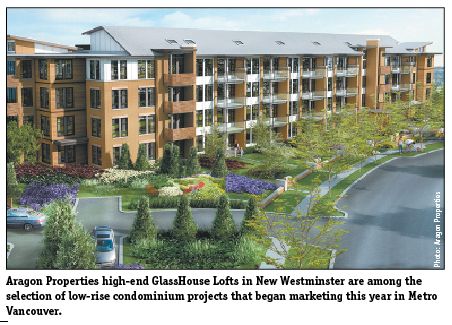Peter Mitham and Frank O’Brien
Other


Notwithstanding an optimistic report from the Real Estate Board of Greater Vancouver touting a hot resale market this summer, activity has been light at Adera Development Corp.’s sales centres since spring.
The pace is “traditional” according to Adera president Norm Couttie, who dismisses talk of tough times for low-rise projects such as Breeze, adjacent to Morgan Crossing in South Surrey. While strict financing conditions have edged out some smaller builders, this has left larger, experienced developers able to pursue a relaxed pace.
“It just seems to be very stable,” he said, nonchalantly. “Sales are slow during the summer … we expect them to pick up again in the fall.”
Couttie’s calm demeanour belies the storm observers detect in market data, which suggest the low-rise market presents a significant hazard to the rest of Metro Vancouver’s housing sector.
The cautionary voices include that of veteran analyst Frank Schliewinsky of Vancouver real estate consulting firm G-Force Group, who notes that the start of the summer saw more than 7,000 high-rise condo units being marketed in Metro Vancouver, or the equivalent of more than a year’s supply based on recent absorption trends.
Meanwhile, there are 5,475 low-rise condos sitting unsold or yet to be released in current projects. And, with absorption of low-rise units averaging 200 units a month, Schliewinsky thinks that’s a problem.
“We’re looking at closer to 26 months of sales in terms of unsold low-rise inventory,” he said. “[And] sales are basically going soft, down a little bit from what they were, [and] inventory is shooting up.”
Combined with a lack of appetite among investors – especially foreign investors – for low-rise product in areas such as Surrey, Schliewinsky feels the volume of low-rise units coming to the market pose a significant risk to the market’s stability.
“The focus of the concerns of the Bank of Canada and some of the other economists has been the high-rise market,” he said. “In fact, [in Metro Vancouver] it could be the low-rise market that’s in much more danger of being over-supplied.”
Schliewinsky’s numbers come from market research firm MPC Intelligence Inc., which notes that up to 10,000 low-rise units could be offered to the market in the next 12 months. But he doesn’t expect everyone to take note. While established developers are savvy, there are plenty whose optimism trump sound business sense
“It’s a hard market to turn around. Even after there’s an evident downturn, the product will still be coming on the market for the next six, 12, 18 months,” Schliewinsky said. “Basically, developers are not in an analytical frame of mind, for the most part. They operate differently. … A lot of the time if [a number] doesn’t agree with their point of view or the vision that they have, they want to dismiss it.”
And that’s plain foolish, as any marketer will confirm.
“You can’t just go blindly into [the low-rise] marketplace and think you’re going to win, because it’s not going to happen that easily,” said Mark Belling, principal of Fifth Avenue Real Estate Ltd.
The past five years have seen a sea change in the market, especially south of the Fraser River. Buyers have become more technologically savvy, arriving at sales centres armed with enough information that sales staff serve largely to confirm the hunches of prospective purchasers.
More important, the potential buyers – who are mostly purchasing as owner-occupiers, not investors – have plenty of choice.
South of the Fraser, Belling said developers continue to move product stalled or otherwise delayed in the wake of the 2008 financial crisis. The completion of the Golden Ears Bridge has also opened up neighbourhoods north of the Fraser to potential residents who were previously limited to areas south of the Fraser.
Meanwhile, the emphasis on more walkable communities and greater densities – even in suburban neighbourhoods – have seen more townhomes than ever introduced by smaller, less-experienced developers.
“[It] allows more developers to play in the townhouse sector, which pulls the price point down in order to compete, which then, as a net effect … is competing head-on with a condo,” Belling said. “A consumer can buy a townhouse of about 1,200 square feet with a ground orientation, which is desirable, for the price of a typical condo around 1,000 square feet.”
It’s no surprise that buyers are consequently gravitating to townhomes, putting pressure on low-rise condo developers that haven’t adjusted their expectations to the market. While both segments of the market are over-supplied, townhomes are doing better at holding their own because a significant differential still exists between them and single-detached properties.
“Condos face two forces in the new-build sector: their own class plus the townhouse sector,” Belling said.
While this may not be good news for developers, many of whom are attempting to sell units either at break-even pricing or below cost, he sees it as good news for buyers – especially when combined with interest rates that remain the lowest they’ve been in a lifetime.
“It’s nothing but win [for buyers],” he said.
Buyer incentives
In Metro Vancouver’s competitive new-condominium market, developers have rolled out a lot of buyer incentives this year. And they’ve worked. An example was the Elliott in New Westminster, aimed at investors, with 130 strata units priced from sub-$200,000 up to $450,000. Censorio Group offered to guarantee rental income for the next seven years at an average of $1,500 per month. The project sold right out.
The Hudson Lofts in Abbotsford offered to accept monthly payments until the project completes, at $200 per month, until buyers had paid the 5 per cent down payment. This project, part of the Central Park Village development, also sold out.
Millennium Group offered buyers of its lowrise Bohème condo development in East Vancouver a free Fiat 500 – 15 cars were awarded as the project sold out – but most incentives are wrinkles to lower the cost of admission for first-time buyers.
The real deals, according to marketer Vince Taylor, president of Pilot House Marketing Ltd., are the ones that prove that a developer “has skin in the game” and is going to be there for the long haul with buyers.
In all cases, developers also want to retain the value of the condos. The idea is to keep prices at the same level but to use creative ways to help more buyers in. For example, a number of developers are offering to waive the sales tax on new townhomes and low-rise condo projects and others are offering free upgrades for the first buyers.
Highrise developers are also offering some generous perks.
Developer Rize Alliance Properties Ltd. has one of the most aggressive of these incentives: $36,000 in cash or in direct monthly payments of $1,000 per month for 36 months to those who buy the last condos in the Rolston in downtown Vancouver, which is about 90 per cent sold out. Prices start at $389,000 for a one-bedroom unit in the tower, with two bedrooms in the $600,000 range.
Another innovative incentive is a chance to win a two-bedroom condominium at Denna Homes’ Seylynn Village project in North Vancouver.
The developer is giving out 5,000 “golden keys” to visitors, one of which will win the home in the first tower of the three-tower project. The gimmick may not be needed however: the project, launched in June, drew long lineups of buyers on opening day and is already 65 per cent sold out.
from Western Investor September 2013
